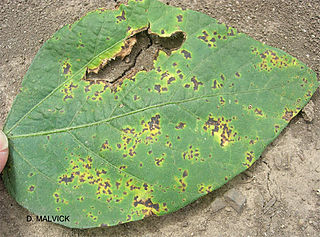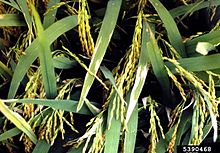
A leaf spot is a limited, discoloured, diseased area of a leaf that is caused by fungal, bacterial or viral plant diseases, or by injuries from nematodes, insects, environmental factors, toxicity or herbicides. These discoloured spots or lesions often have a centre of necrosis. Symptoms can overlap across causal agents, however differing signs and symptoms of certain pathogens can lead to the diagnosis of the type of leaf spot disease. Prolonged wet and humid conditions promote leaf spot disease and most pathogens are spread by wind, splashing rain or irrigation that carry the disease to other leaves.

Magnaporthe grisea, also known as rice blast fungus, rice rotten neck, rice seedling blight, blast of rice, oval leaf spot of graminea, pitting disease, ryegrass blast, Johnson spot, neck blast, wheat blast and Imochi (稲熱), is a plant-pathogenic fungus and model organism that causes a serious disease affecting rice. It is now known that M. grisea consists of a cryptic species complex containing at least two biological species that have clear genetic differences and do not interbreed. Complex members isolated from Digitaria have been more narrowly defined as M. grisea. The remaining members of the complex isolated from rice and a variety of other hosts have been renamed Magnaporthe oryzae, within the same M. grisea complex. Confusion on which of these two names to use for the rice blast pathogen remains, as both are now used by different authors.

Citrus canker is a disease affecting Citrus species caused by the bacterium Xanthomonas. Infection causes lesions on the leaves, stems, and fruit of citrus trees, including lime, oranges, and grapefruit. While not harmful to humans, canker significantly affects the vitality of citrus trees, causing leaves and fruit to drop prematurely; a fruit infected with canker is safe to eat, but too unsightly to be sold. Citrus canker is mainly a leaf-spotting and rind-blemishing disease, but when conditions are highly favorable, it can cause defoliation, shoot dieback, and fruit drop.
Bacterial blight is a disease of barley caused by the bacterial pathogen Xanthomonas campestris pv. translucens. It has been known as a disease since the late 19th century. It has a worldwide distribution.

Xanthomonas campestris is a gram-negative, obligate aerobic bacterium that is a member of the Xanthomonas genus, which is a group of bacteria that are commonly known for their association with plant disease. This species includes Xanthomonas campestris pv. campestris the cause of black rot of brassicas, one of the most important diseases of brasicas worldwide.

Xanthomonas is a genus of bacteria, many of which cause plant diseases. There are at least 27 plant associated Xanthomonas spp., that all together infect at least 400 plant species. Different species typically have specific host and/or tissue range and colonization strategies.

Halo blight of bean is a bacterial disease caused by Pseudomonas syringae pv. phaseolicola. Halo blight’s pathogen is a gram-negative, aerobic, polar-flagellated and non-spore forming bacteria. This bacterial disease was first discovered in the early 1920s, and rapidly became the major disease of beans throughout the world. The disease favors the places where temperatures are moderate and plentiful inoculum is available.
Xanthomonas arboricola is a species of bacteria. This phytopathogenic bacterium can cause disease in trees like Prunus, hazelnut and walnut.
Xanthomonas fragariae is a species of bacteria. It causes a leaf spot disease found in strawberries. The type strain is NCPPB1469 from Fragaria chiloensis var. ananassa.
Xanthomonas oryzae is a species of bacteria. The major host of the bacterium is rice.

Xanthomonas vasicola pv. vasculorum (Xvv) is a gram-negative rod-shaped bacterium which has a single polar flagellum. It is a plant pathogen, causing both bacterial leaf streak of maize (corn) and sugarcane gumming disease. One outbreak in eucalyptus has been reported. Under experimental conditions it can infect sorghum, oats and some grass species. It is not currently a quarantine pathogen in any country, but it has already spread outside its native range and is highly adaptable to different environments.
Black rot, caused by the bacterium Xanthomonas campestris pv. campestris (Xcc), is considered the most important and most destructive disease of crucifers, infecting all cultivated varieties of brassicas worldwide. This disease was first described by botanist and entomologist Harrison Garman in Lexington, Kentucky, US in 1889. Since then, it has been found in nearly every country in which vegetable brassicas are commercially cultivated.

Banana Xanthomonas Wilt (BXW), or banana bacterial wilt (BBW) or enset wilt is a bacterial disease caused by Xanthomonas campestris pv. musacearum. After being originally identified on a close relative of banana, Ensete ventricosum, in Ethiopia in the 1960s, BXW emanated in Uganda in 2001 affecting all types of banana cultivars. Since then BXW has been diagnosed in Central and East Africa including banana growing regions of: Rwanda, Democratic Republic of the Congo, Tanzania, Kenya, Burundi, and Uganda.

Xanthomonas campestris pv. vesicatoria is a bacterium that causes bacterial leaf spot (BLS) on peppers and tomatoes. It is a gram-negative and rod-shaped. It causes symptoms throughout the above-ground portion of the plant including leaf spots, fruit spots and stem cankers. Since this bacterium cannot live in soil for more than a few weeks and survives as inoculum on plant debris, removal of dead plant material and chemical applications to living plants are considered effective control mechanisms.
Bacterial blight of cotton is a disease affecting the cotton plant resulting from infection by Xanthomonas axonopodis pathovar malvacearum (Xcm) a Gram negative, motile rod-shaped, non spore-forming bacterium with a single polar flagellum
Xanthomonas axonopodis pv. manihotis is the pathogen that causes bacterial blight of cassava. Originally discovered in Brazil in 1912, the disease has followed the cultivation of cassava across the world. Among diseases which afflict cassava worldwide, bacterial blight causes the largest losses in terms of yield.
Bacterial wilt of turfgrass is the only known bacterial disease of turf. The causal agent is the Gram negative bacterium Xanthomonas translucens pv. graminis. The first case of bacterial wilt of turf was reported in a cultivar of creeping bentgrass known as Toronto or C-15, which is found throughout the midwestern United States. Until the causal agent was identified in 1984, the disease was referred to simply as C-15 decline. This disease is almost exclusively found on putting greens at golf courses where extensive mowing creates wounds in the grass which the pathogen uses in order to enter the host and cause disease.
Bacterial leaf streak (BLS), also known as black chaff, is a common bacterial disease of wheat. The disease is caused by the bacterial species Xanthomonas translucens pv. undulosa. The pathogen is found globally, but is a primary problem in the US in the lower mid-south and can reduce yields by up to 40 percent.[6] BLS is primarily seed-borne and survives in and on the seed, but may also survive in crop residue in the soil in the off-season. During the growing season, the bacteria may transfer from plant to plant by contact, but it is primarily spread by rain, wind and insect contact. The bacteria thrives in moist environments, and produces a cream to yellow bacterial ooze, which, when dry, appears light colored and scale-like, resulting in a streak on the leaves. The invasion of the head of wheat causes bands of necrotic tissue on the awns, which is called Black Chaff.[14] The disease is not easily managed, as there are no pesticides on the market for treatment of the infection. There are some resistant cultivars available, but no seed treatment exists. Some integrated pest management (IPM) techniques may be used to assist with preventing infection although, none will completely prevent the disease.[2]

Bacterial blight of soybean is a widespread disease of soybeans caused by Pseudomonas syringaepv. glycinea.
Xanthomonas campestris pv. juglandis is an anaerobic, Gram negative, rod-shaped bacteria that can affect walnut trees though the flowers, buds, shoots, branches, trunk, and fruit. It can have devastating effects including premature fruit drop and lesions on the plant. This pathogen was first isolated by Newton B. Pierce in California in 1896 and was then named Pseudomonas juglandis. In 1905 it was reclassified as Bacterium juglandis, in 1930 it became Phytomas juglandis, and in 1939 it was named Xanthomas juglandis. The International Standards for Naming Pathovars declared it to be named Xanthomonas campestris pv. juglandis in 1980. There have been recent proposals to change the name once again to Xanthomonas arboricola pv. juglandis, but this has not yet been universally accepted.










